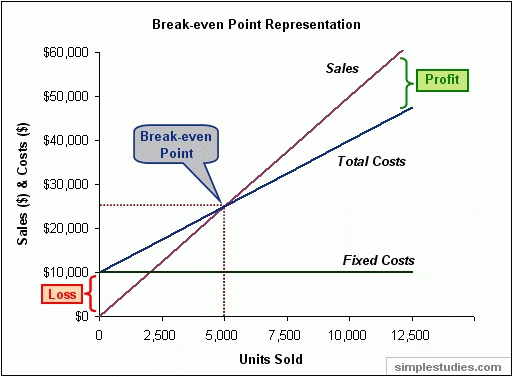Break-even is the point where the profit
and loss are exactly equal. This point reflects the moment when the investor
can get returned after his investment. Break-even indicates also the point of
balance between sales income and prime cost (use in distribution for example). At this point, theres’s neither
profit nor loss, although opportunity costs have been paid. When a company
fixes prices or decides its marginal profits, the break-even serves as a
critical point of making profits. Therefore, it’s important to make use of the break-even
point in management strategies. This point can be widely used in product
marketing, investment or even a company’s entire business. In the option area ,
it is also helpful. For options, break-even indicates the exact market price
that should be reached. Only at this price can buyers not be in a loss.
Break-even analysis is a useful tool to study the relation among the fixed
cost, changing cost and profits. The analysis shows in a visible and direct way
when to get the costs returned with a chart or a formula. Through the analysis,
we come to know, within a given price, what the size of production should be to
cover the total costs. Similarly, we get to know, within a given quantity of production, what the price should be to cover the total coats.Usually, we use a
chart as seen below to get the results. From the break-even point, we begin to
make profits.
To make a more accurate analysis, we often
use some formulas to work out the final results. It’s BEP = TFC/(SUP - VCUP). Here, BEP =
Break-even Point, TFC = Total Fixed Costs, VCUP = Variable Costs per Unit of
Production, SUP = Selling Price Per Unit of Production.
Nowadays, more and more companies apply the
analysis for the sake of a better profit and favorable financing strategies.
For the most of time, when one wants to open up a start-up, he should draw up a
financial planning with which he can make a clear understanding of his further
financial situation. This point allows him to make or modify others’ decisions.
For example, if a company finds that his predefined investment can’t cover the
total cost before arriving at break-even point, it may probably seek for other
investors, cooperators or cut down its fixed cost(equipments, factories,
administrative expenses, etc).
Though break-even is widely used in
financial evaluation and profit-loss forecast, it has also some restrictions.
Firstly, each analysis conforms only to a single product. Secondly, it’s
difficult to classify the fixed cost and the changing cost. Sometimes, the
functional relation between the prime cost and income has changed, but the
operator doesn’t recognized it. So with the previous analysis, he or she may
get wrong results, which could lead to a loss.

Aucun commentaire:
Enregistrer un commentaire